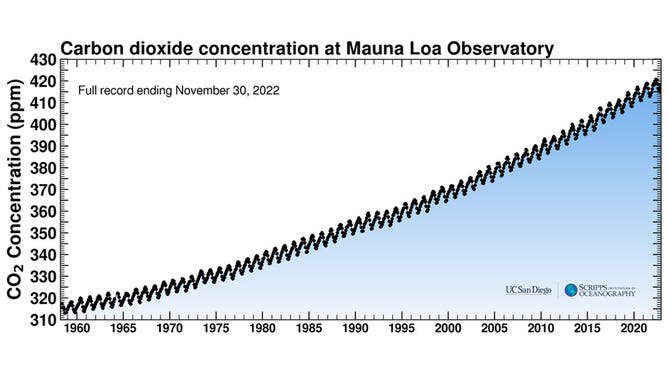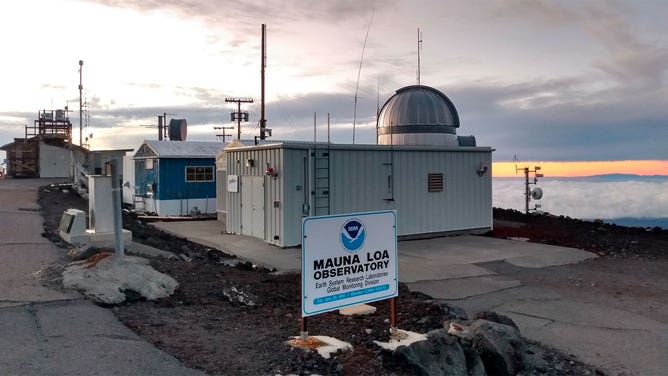Key climate change monitoring site taken offline by Mauna Loa eruption
Equipment used to measure carbon dioxide levels at the Mauna Loa Observatory isn’t functioning after the volcano’s eruption destroyed power lines.
Watch: Lava flows continue on Hawaii's Mauna Loa volcano
Lava is continuing to flow from Hawaii's Mauna Loa volcano, which began to erupt on November 27, 2022.
MAUNA LOA, Hawaii – Equipment used to take key climate change measurements has gone offline this week after the eruption of Mauna Loa destroyed power lines in the area.
Mauna Loa, the world’s largest active volcano, began erupting late Sunday night after nearly 40 years of quiet. Video has shown lava shooting about 150 feet into the air from one of several fissures as streams of molten rock ooze across the landscape.
Officials said lava flows crossed the road leading to the Mauna Loa Observatory on Monday night and took out lines that power the mountaintop site, which is operated by the National Oceanic and Atmospheric Administration.
The observatory also houses equipment used by researchers at the Scripps Institution of Oceanography at UC San Diego that has taken nearly daily measurements of carbon dioxide concentrations in the atmosphere for the past 60 years. This data is what led to the establishment of the Keeling Curve, showing how CO2 levels have increased dramatically since the start of the 20th Century. This has served as scientific evidence that human activities are changing the Earth’s climate.
LATEST CO2 RECORD DETECTED IN HAWAII SHOWS LEVELS CONTINUE THEIR DECADES-LONG CLIMB

The Keeling Curve shows atmospheric concentrations of carbon dioxide
(Scripps Oceanography/UC San Diego)
Officials at Scripps Oceanography said the site went offline Monday, and researchers are exploring whether the equipment should be relocated.
In a press release, Ralph Keeling, a geoscientist at Scripps Oceanography and son of Keeling Curve creator Charles David Keeling, said the outlook for the future of readings from the Hawaii-based station as "very troubling."
"It’s a big eruption, and it’s in a bad place," Keeling said.
The uninterrupted nature of the record is one of the biggest advantages of the Keeling Curve, but this isn’t the first time data collection has been paused. Budget cuts led to a lack of measurements in 1964, and the last Mauna Loa eruption in 1984 caused operations to be suspended for more than a month, according to officials.
Carbon dioxide is among the most potent of all greenhouse gases. It comes from not only the burning of fossil fuels but also wildfires and volcanic eruptions. It can trap heat in the atmosphere for centuries.
MAJOR GREENHOUSE GASES INCREASED LAST YEAR BUT METHANE HIT RECORD LEVELS, REPORT SAYS

The Mauna Loa Observatory in Hawaii is seen in 2020.
(NOAA)
In addition to the CO2 measurements taken by the Scripps team, the NOAA-managed site records plenty of other data used to increase understanding of both meteorology and climate change.
NOAA officials said data collection was paused Tuesday because of the power outage and that access to the facility has been cut off. All staff at the observatory are safe, and efforts to restore power to the site are being explored.
"We are quickly implementing plans to make measurements, including radiation, greenhouse gasses, aerosols and ozone-depleting substances, at other locations," said Alison Gillespie, public affairs specialist at NOAA, in a statement to FOX Weather.
Since 1843, Mauna Loa has erupted 33 times, averaging an eruption every 5 years. However, most eruptions before 1950 had an average frequency of 3.5 years. Since 1950, there have only been two eruptions – a summit eruption in 1975 and a rift eruption in 1984.
It had been the longest quiet period on record for Mauna Loa before Sunday night's eruption.
